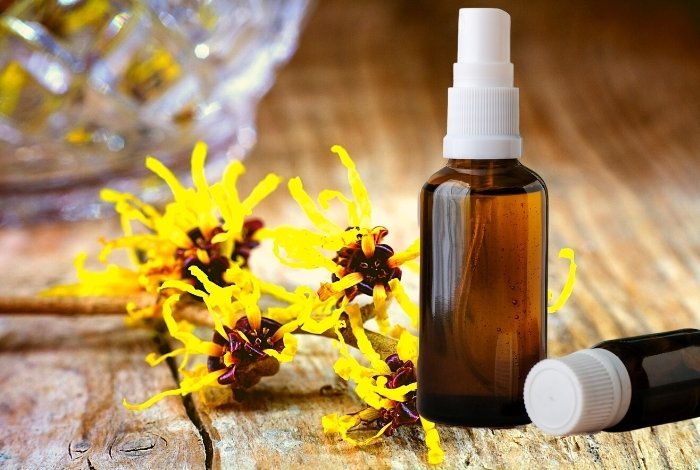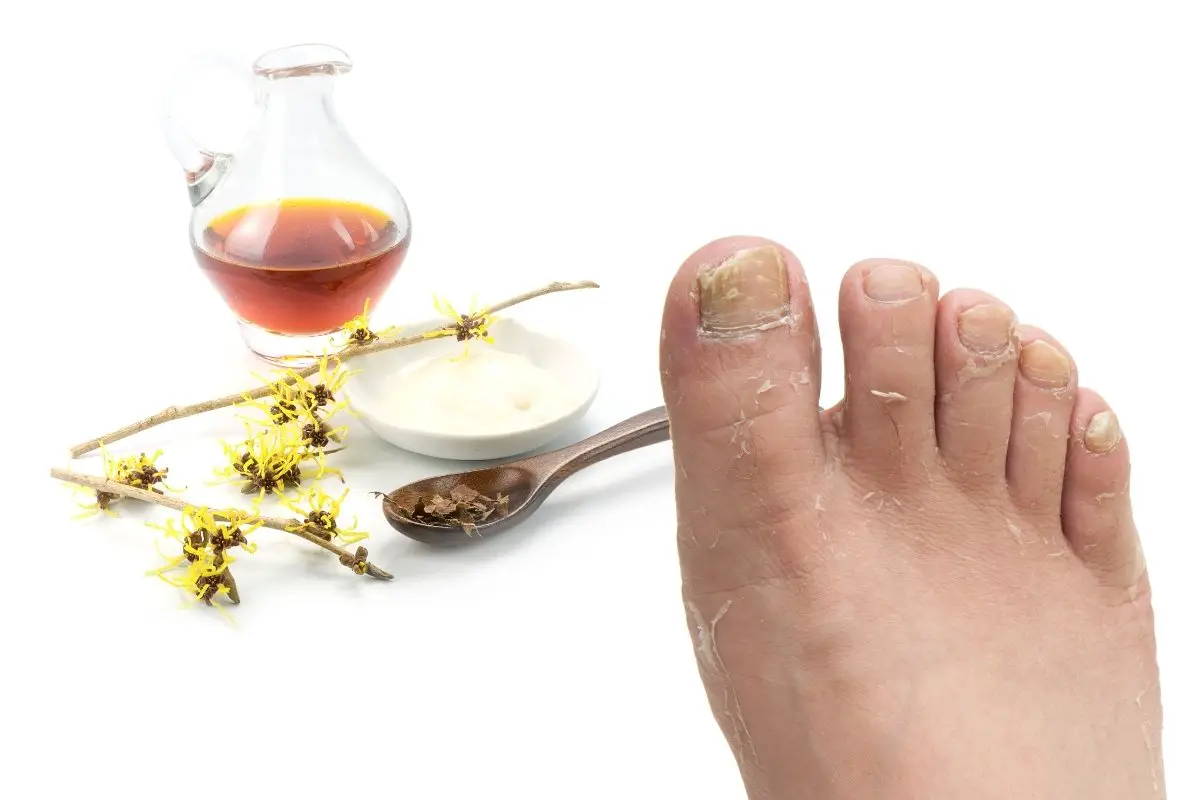Last Updated on October 10, 2024
While you can find herbal remedies available for any type of infection that affects the skin and one common one is athlete’s foot. The condition is caused by a fungal infection and can be treated with simple home remedies. And if you wonder how safe it is to use witch hazel for athlete’s foot, you will discover all the secrets there is to know in the sections below.
Table of Contents
What Is an Athlete’s Foot?
You may have suffered it in the past. It is a fungal infection that occurs between the toes of the feet. It occurs mainly due to the heating and sweating that takes place inside a tight-fitting shoe. While it might not look like something serious at first, if left untreated, it could spiral into the nails can cause a fungal nail infection, which could become even more complicated to treat.
Causes Of Athlete’s Foot?
You should know that the fungus responsible for the condition only thrives in moist surroundings. This is why you could also be at risk of swimming in the pool or using the public shower. But the good part is there is nothing to bother about if you happen to be with a scaly or patchy foot. Some of the primary causes of athlete’s foot include
- Wearing tight-fitting shoes
- Swimming in a poorly maintained pool
- Showering in an unhygienic bathroom
- Direct contact with someone who has the fungus on their skin. This is common if you share footwear and socks with others.
- Walking in flooded streets is another way you could quickly get infections in your foot.
Using Witch Hazel For Athlete’s Foot
When it comes to available treatment for many fungal infections, most people choose to go for pharmaceutical products. There is no reason why you shouldn’t. If you think that’s the best way to go. But for most natural medicine enthusiasts, find the flowering plant witch hazel to be useful when it comes to easing the symptoms and conditions of an athlete’s foot.
The witch hazel plant has often in the past being taunted to provide a lot of health benefits, especially when it comes to easing the symptoms of inflammation and soothing sensitive skin. And this is why it is quite popular as the go-to remedy for treating athlete’s foot. But most people, may not be aware of how best to use the plant when it comes to treating skin conditions.
Dickinson’s Original Witch Hazel Pore Perfecting Toner, 100% Natural
How To Use Witch Hazel Antifungal
You should start by grabbing an adequate quality supply from the pharmacy and including other essential oils with anti-fungal and anti-bacterial properties to go. This will help make the solution to packing a hefty punch to treat the athlete’s foot. So to get started, below are the list of essential ingredients required.
- 5 drops of tea tree oil
- 5 drops of oregano oil
- 5 drops of lavender oil
- 10 drops of clove oil
- 20ML of witch hazel juice
- 30ML glass spray bottle
Once we’ve got everything assembled, the next thing will be to get right into the preparation, and you want to be particular with how you do that. For starters, ensure the supplies are of the best quality and keep the glass spray bottle dry, so you don’t contaminate the preparation once ready. That said, you can find the simple preparation instruction below to make your witch hazel for athlete’s foot home remedy.
Preparation
There is no particular order of preparation here than to combine all the ingredients and mix thoroughly. Start with the essential oils slowly into the dry glass spray bottle. Slowly add in the witch hazel to fill up the bottle. You will have to mix the ingredients properly. It could be impossible to obtain a complete dissolution with the different oils, but you want to ensure that it does blend right in the bottle.

How to Use Witch Hazel for Athlete’s Foot Safely?
Once you have prepared the unique home remedy using witch hazel and essential oils, you will then have to use it properly on the foot. You should know that the preparation would sting when it comes in contact with the open sore caused by the condition. So be well ready to contend with it for the first few applications. You want to use it as a topical treatment only and avoid consuming it orally. It could cause stomach upset or worse if you consume it to treat the same condition.
Can You Pass Athlete’s Foot to a Baby?
Although the chances are very low, there is still a possibility of passing the athlete’s foot to your baby. As we have already stated, this disease is typically transmitted through direct contact with infected surfaces or through sharing contaminated items, such as towels or shoes. Given that babies don’t typically come into contact with the same surfaces or items that adults do, the risk of passing this fungal disease on to your youngest household member is very small.
If you suffer from this condition and still have a small child to care for, the best thing you can do is wash your hands often and keep your feet clean and dry to reduce the risk of spreading the infection to others and thus to the youngest family members. Finally, it is imperative to avoid sharing towels, shoes, or other personal items with others, including your baby, to prevent the spread of infection.
Here is everything you need to know about this disease when it comes to the youngest.
Will A & D Ointment Help Athlete’s Foot?
A & D ointment is a combination of vitamins A and D and is not typically used to treat athlete’s foot. On the contrary, its primary purpose is to treat diaper rash, dry or chafed skin, and minor cuts or burns.
However, it is important to say that since it is a skin protectant, it can provide some relief for an athlete’s foot, but it is not generally considered a primary treatment for this condition. The point is that this ointment can relieve the most common symptoms of this fungal disease, such as itching, burning, cracked, red or flaky skin, but it cannot cure the disease.
Does Hot Water Make Athlete’s Foot Worse?
As you can probably guess, it is not uncommon for hot water to make the symptoms of an athlete’s foot worse. Like the vast majority of fungi, the main causes of this skin condition love warm and moist environments, so, accordingly, hot water can create a suitable breeding ground for fungi to grow and multiply. Using too hot water during a shower or foot bath can unfortunately lead to an increase in the severity of the infection and the intensity of the symptoms.
Does Vitamin C Help Athlete’s Foot?
Vitamin C is an essential nutrient that is important for maintaining a healthy immune system. It is known as one of the most potent antioxidants that protect our body cells from the destructive effects of free radicals, which are unstable molecules that can contribute to the development of various diseases, probably including athlete’s foot. Vitamin C is also involved in the production of collagen, a protein that is essential for the formation of skin, blood vessels, and connective tissues.
Although frankly, there is not enough scientific evidence to support the use of vitamin C for the treatment of athlete’s foot, we cannot rule out its role in boosting immunity, which helps us fight various body infections. Considering the antioxidant properties of vitamin C, a high-potency vitamin C pill should help boost your immune system while treating an athlete’s foot. Click here to learn more about its role in the treatment of skin diseases.
How Do I Know When My Athlete’s Foot is Gone?
Generally speaking, as with everything else, it is recommended to continue using the antifungal medication for the full course of treatment, even if the symptoms have improved. This is the only safe way to completely remove the fungus and prevent re-infection.
This skin disease has likely been effectively cured if you have completed the suggested course of treatment and your symptoms have disappeared. In short, with proper diagnosis and treatment, your athlete’s foot should go away within one to eight weeks, depending on how severe it was.
Are Foot Masks Good For Athlete’s Foot?
Foot masks aren’t usually considered a primary treatment for athletes’ feet. The thing is that they are made to moisturize and soften the skin of the feet, but unfortunately in this case they aren’t very useful, because they don’t contain ingredients that are specifically designed to kill the fungus that causes the infection.
However, foot masks can be used to relieve the most common symptoms of this condition, including itching, inflammation, burning sensation, and white, as well as painful and scaly spots on the skin. But again, it’s important to remember that this will not treat the underlying infection.
Final Note
Witch hazel could be an effective treatment for an athlete’s foot. It could also help with other complicated skin conditions where you only want to consider a natural remedy.

Barbara is an environmental activist and sustainability advocate who loves living green and sustainable. She firmly believes in reducing her carbon footprint and has been making great strides towards achieving this goal. Barbara is a vegan and avid recycler and has been actively involved in community gardens and other green initiatives. She is passionate about spreading awareness about the importance of living in a sustainable and eco-friendly manner. Barbara is always looking for ways to make a difference in her community and beyond. She is a huge advocate for preserving nature and the planet for future generations.


